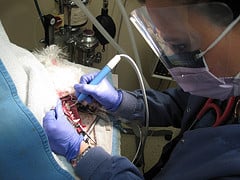 One of the most common reasons owners neglect dental care or other procedures for their pet is fear of anesthesia. In fact, many owners have either had a negative experience surrounding anesthesia with a previous pet or with themselves, or have a friend who had a bad experience. Veterinary medicine has come a long way in terms of standards of care and many people do not realize how advanced our anesthesia protocols and procedures have become.
One of the most common reasons owners neglect dental care or other procedures for their pet is fear of anesthesia. In fact, many owners have either had a negative experience surrounding anesthesia with a previous pet or with themselves, or have a friend who had a bad experience. Veterinary medicine has come a long way in terms of standards of care and many people do not realize how advanced our anesthesia protocols and procedures have become.
It is crucial to communicate with clients regarding the doctor's recommendations and to communicate with them about their fears of anesthesia. Most owners don't even know what anesthesia entails. They just think the pet goes to sleep and may never wake up. Tell them the precautions you take at your hospital to make sure that their pet is a good anesthesia candidate. They should have a full physical exam by the doctor and bloodwork to check their liver and kidney status prior to anesthesia.
HOW TO DISCUSS ANESTHESIA
1) Tell the client about how long their pet will be under anesthesia. (i.e. Let them know that to clean their pet's teeth and to perform the extraction will take about 30-45 minutes, or the spay should take about 15 minutes for the procedure but about 30 minutes total of anesthesia to include the shave and scrub the abdomen and get "Sophie" hooked up to the monitoring equipment.) Use the pet's name when talking about these procedures.
2) Talk about the monitoring equipment when you mention it as above. Let them know you monitor the ECG and blood pressure. Let them know you constantly monitor their oxygenation and CO2 and keep record of their values. Discuss that you keep them on heat support so they stay nice and warm during the procedure and they will be on IV fluids to keep their blood pressure stable. They will have a tube placed in their trachea so that their airway is controlled. Sometimes it helps to give clients a tour of the surgery or anesthesia suites. It helps them to visualize where their pet will be and may help them to feel more confident.
3) Discuss specifics of anesthetic drugs. When they drop off the pet, let them know they will receive a pre-medication so they will be nice and relaxed and so you can get the IV placed and start the fluids. Depending on which anesthetics you use, let them know what recovery time is to be expected. Let them know that the anesthetic plan is tailored to each individual patient, and that the doctor will calculate the specific medications just for "Sophie".
4) Do pre and post-op calls to the owner. Some people want to be called before and after while others just want to be called after. Ask them what they would like. It is always a relief to the client to know when the procedure is finished and hear that their pet is extubated and awake. Many times there are multiple procedures scheduled. It is helpful to give them an approximate time as to when their pet may be having their procedure. You don't want them to call at 1 pm and wonder why their pet hasn't had their dental yet. Keep open communication and if the procedure is pushed back due to an emergency, let them know! They should feel that their pet is a priority.
5) Tell them you will take great care of their pet. If there were to be any complications arrise they would be contacted immediately. Make sure to get a phone number and make sure they will be available at that number in case they need to be reached.
6) Ask them if they have any questions about anesthesia or the scheduled procedure. Make sure you answer all of their questions. If they have questions and you don't know how to answer, have the doctor answer them. The doctor should go over the more serious risks of anesthesia or their procedure and discuss risk vs. benefit of the procedure to be performed. This is best done at the time of the physical exam.


 One of the most common reasons owners neglect dental care or other procedures for their pet is fear of anesthesia. In fact, many owners have either had a negative experience surrounding anesthesia with a previous pet or with themselves, or have a friend who had a bad experience. Veterinary medicine has come a long way in terms of standards of care and many people do not realize how advanced our anesthesia protocols and procedures have become.
One of the most common reasons owners neglect dental care or other procedures for their pet is fear of anesthesia. In fact, many owners have either had a negative experience surrounding anesthesia with a previous pet or with themselves, or have a friend who had a bad experience. Veterinary medicine has come a long way in terms of standards of care and many people do not realize how advanced our anesthesia protocols and procedures have become.